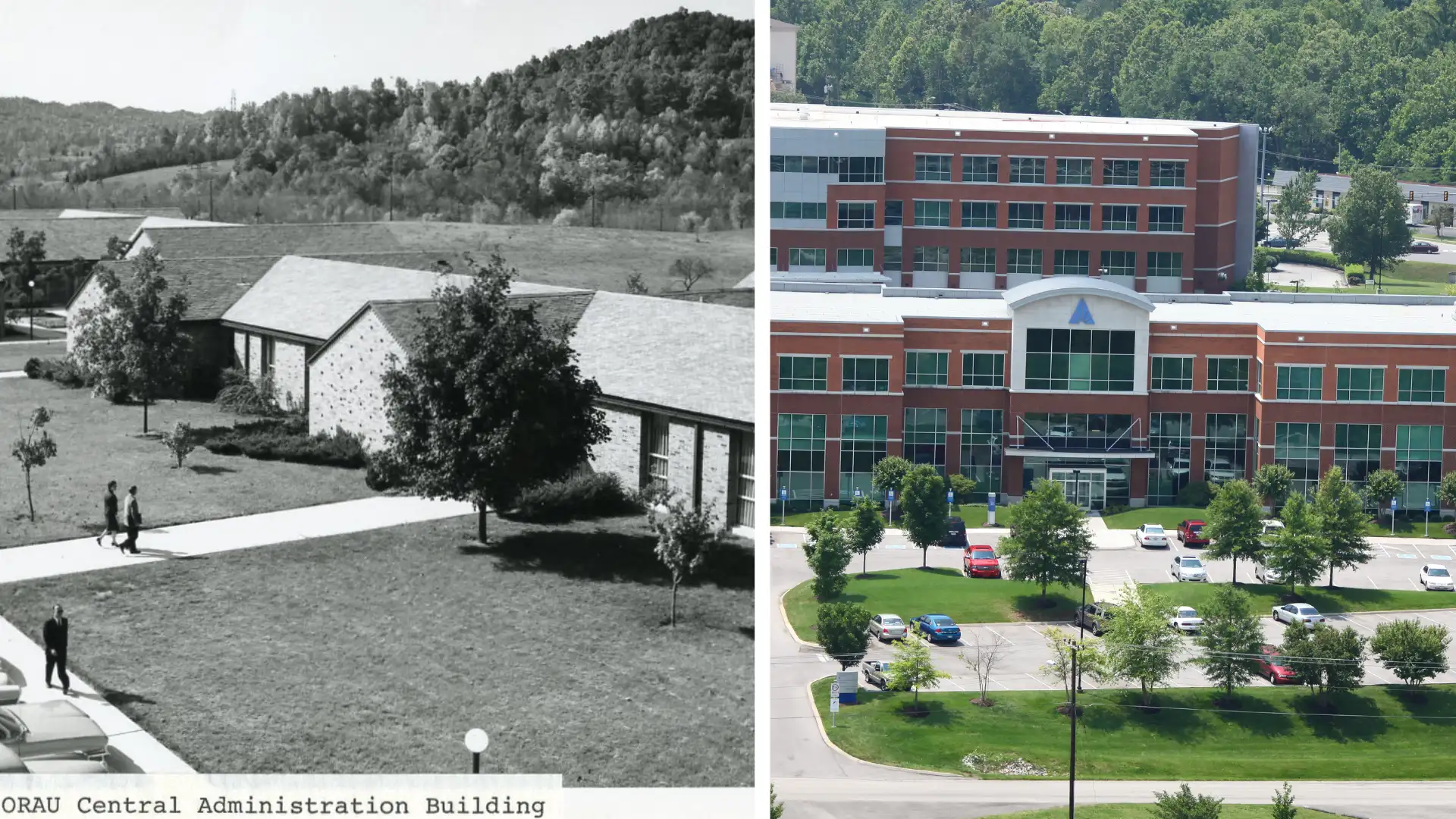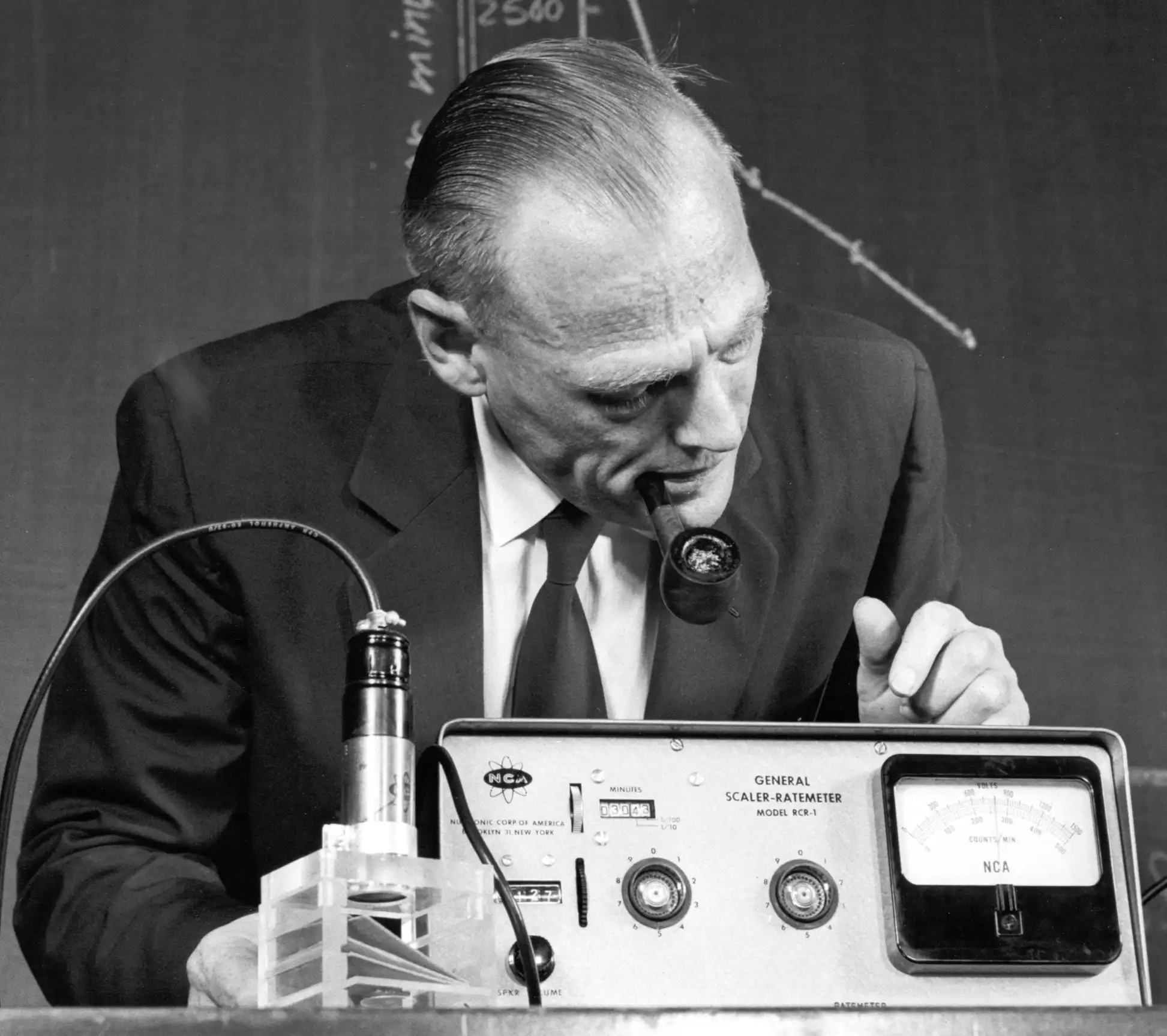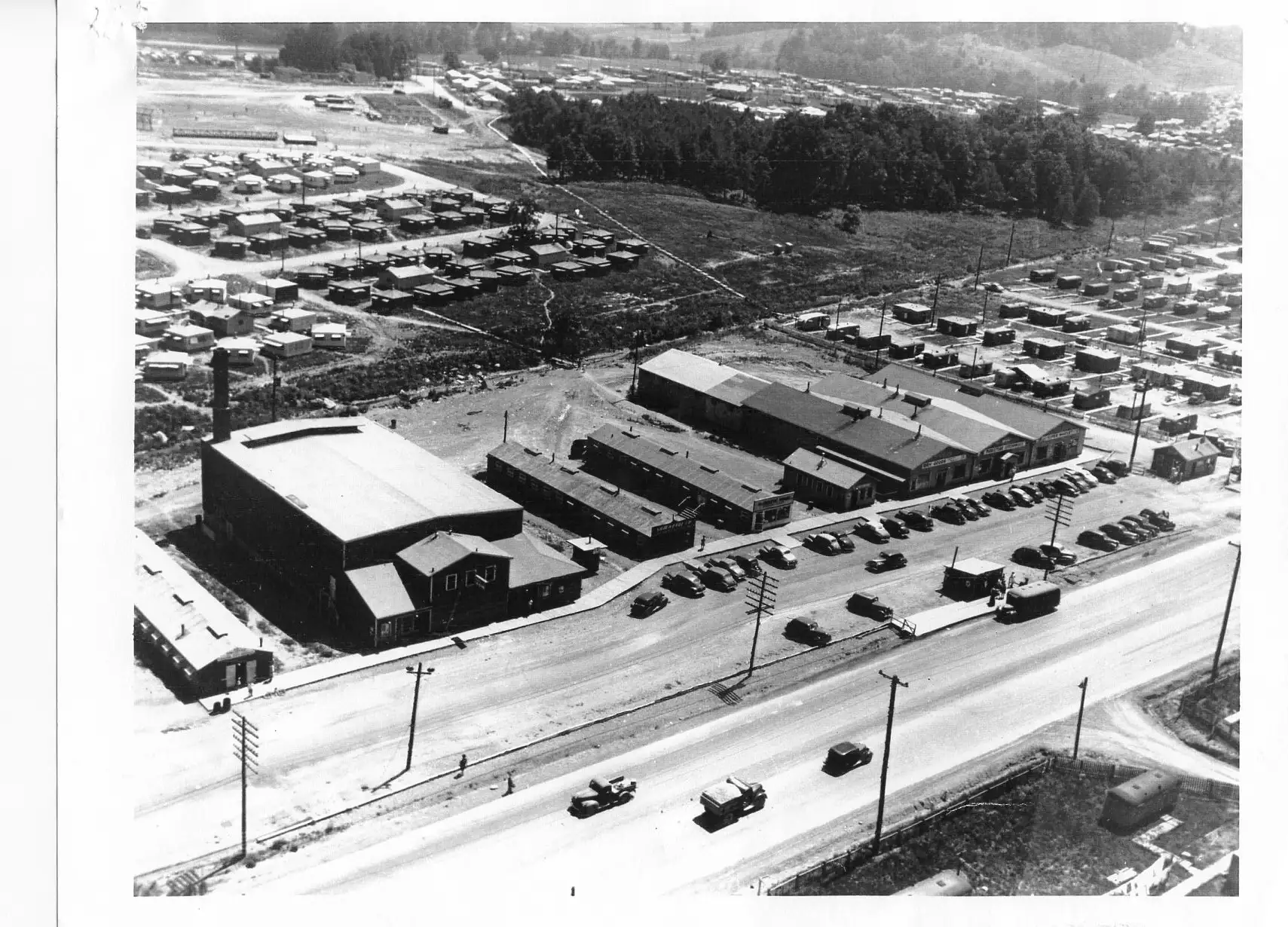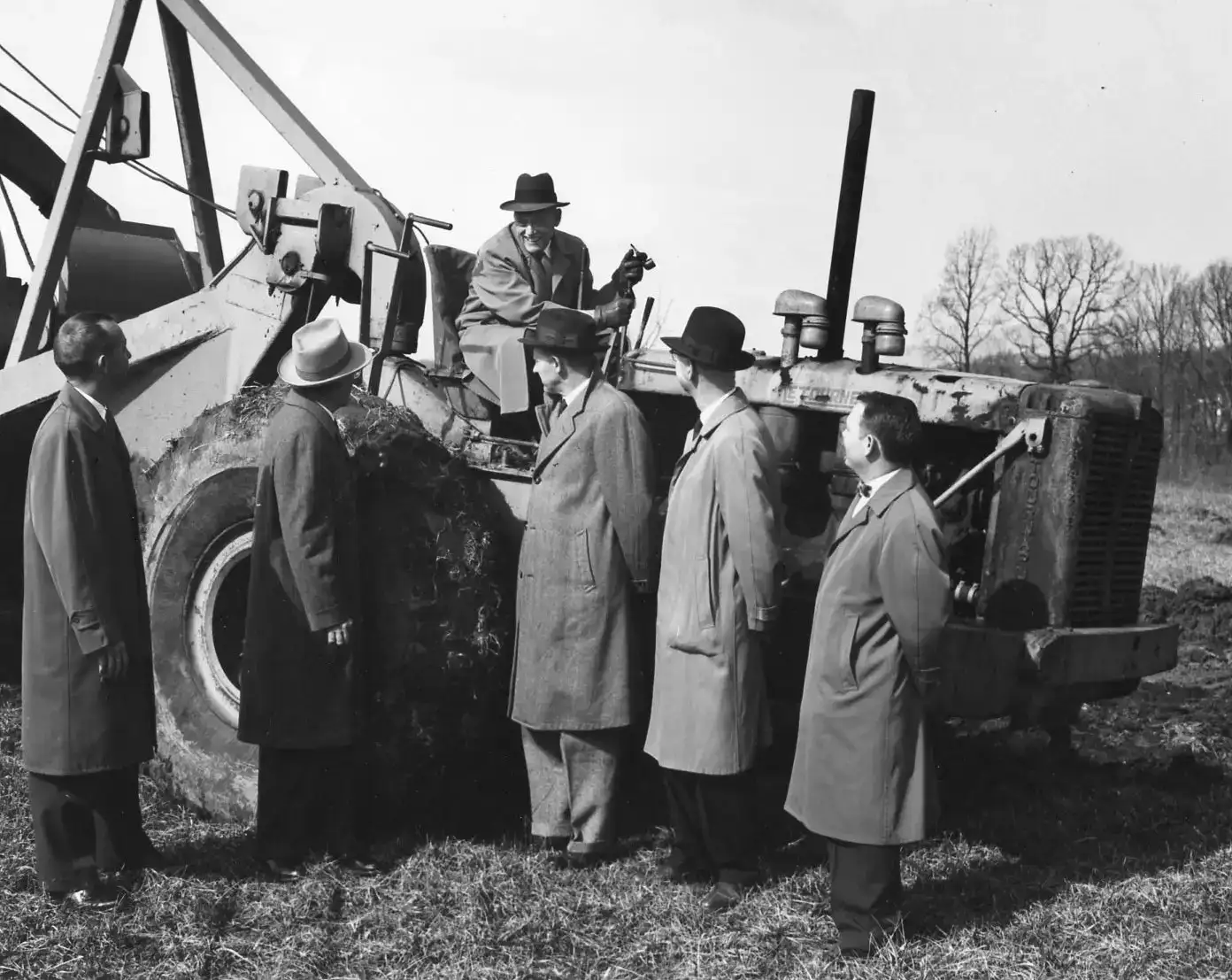
ORAU’s original administration building (left) and the current offices (right)
In 2024, ORAU celebrates 78 years as an organization. That’s because in 1946, Dr. William Pollard secured a charter of incorporation to establish Oak Ridge Institute of Nuclear Studies (ORINS—which was later renamed to Oak Ridge Associated Universities, or ORAU). But the history of this company is rooted in the years leading up to 1946—specifically, in the Manhattan Project, the top-secret program created to build the first atomic bombs during World War II.
In the early 1940s, the federal government identified a small community called Elza, Tennessee, as the perfect place to relocate the Manhattan Project’s headquarters. The city name “Oak Ridge” would be adopted later in hopes it was non-descript enough to not raise interest, and thus, remain a “secret city.”
So, how did building nuclear weapons lead to the birth of ORAU? Let’s back up and give this explanation a proper foundation.
Pre-war collegiate atmosphere
In the late 1930s and early 1940s, scientific research centers in the United States dotted the Northeast, Midwest and state of California. Meanwhile, universities in the South were known as undergraduate institutions—Southern schools were educators of students who would go on to distinguished graduate research programs in other regions.
Many young professors who had joined Southern faculties after exciting doctoral and postdoctoral research experiences were chafed at the lack of opportunities at their own schools. One of those disillusioned educators was University of Tennessee physicist William Pollard, Ph.D. His chance to gain access into a highly-respected research program came with an invitation to conduct research into a gaseous diffusion extraction method of U-235 from uranium for the Manhattan Project.

William Pollard, Ph.D., was a University of Tennessee professor who was invited to participate in research for the Manhattan Project during WWII.
Hold onto that thought. We’ll come back to it.
Wartime
In 1942, the United States was at war. Albert Einstein had already written a letter to President Franklin Roosevelt warning him that he believed the Nazis were developing atomic weapons. Once resolute, the president moved swiftly to organize a secret offensive strategy. Einstein advised Roosevelt to focus on enriching uranium as scientists continue their research setting up a nuclear chain reaction. They needed a lot of space for production plants.
Federal scouts agreed the primary location should be built in the rural valleys and ridges of the quiet region of East Tennessee as much for its geographical advantages as its proximity to the new Tennessee Valley Authority dam in Norris, Tennessee (i.e., electrical power and cooling waters). Though Oak Ridge was not on the map, it was the fifth largest city in the state by 1945—a population boom from about 3,000 to more than 75,000!

Aerial picture of Oak Ridge and the Manhattan Project during WWII
The uranium that was enriched in Oak Ridge was used in the “Little Boy” bomb that was ultimately dropped on Hiroshima, Japan. That effort led to the end of World War II.
The beginning of ORAU
While a welcome change, peace meant a shift for thousands of civilians who returned to jobs that had been put on pause. Like in the case of Dr. Pollard, the government recruited numerous Southern university faculty members in physics, chemistry and engineering to take leaves of absence to support research efforts in their endeavor to build nuclear weapons. As they returned to their schools, they returned with determination and vigor for building their own research and graduate programs at home.
A conversation Pollard had with colleague Katharine Way sparked an idea: as a byproduct of the war, the government placed a major scientific research laboratory in the backyard of the University of Tennessee (and near many other universities in the South). In the past few years, there had been a steady stream of the nation’s most distinguished scientists passing through Oak Ridge. Why did that need to end now?
The Department of Energy agreed it was still advantageous to continue studying peaceful uses of the power contained in the atom and radioisotopes as research tools. So, it was the beginning of ORAU. Pollard created ORINS which included 14 founding universities.

Pollard breaking ground for new ORAU facility in Oak Ridge
The federal government (specifically, the newly created Atomic Energy Commission, which would later become the Department of Energy) contracted ORINS to advise them on acquiring scientific personnel and to liaise with Clinton Engineer Works (the Oak Ridge production unit of the Manhattan Project) and with educational institutions. The first meeting occurred on Oct. 17, 1946.
The rest (you could say) is history, but since this is essentially a history lesson, here are a few more tidbits:
- The early years focused on medical research and cancer treatment. Much of what ORINS learned about radiation led to how doctors treat patients around the globe today. Read more in this blog: Seven Important Gifts the World Received from the ORAU Medical Division.
- With the introduction of the American Museum of Atomic Energy, ORINS’ national role in educating the public in science and technology was established.
- Pollard led ORAU to a position of influence in science and education in the organization’s interactions with the federal government. Today, we work with 28 federal agencies including the Department of Energy (DOE), NASA, CDC and EPA.
- To reflect the growing role university partnerships were playing within the organization, ORINS became ORAU (Oak Ridge Associated Universities) in 1966. The research and advancements that come from projects at our partner universities truly move the country forward.
- As the U.S. government’s strategy for nuclear weapons began to shift, other priorities rose to the top, thus, DOE officially established the Oak Ridge Institute for Science and Education (ORISE) in 1992 to provide integrated support to achieve varied missions and help the agency address critical needs. Through a contract with DOE, ORAU manages ORISE.
- Fukushima, Japan suffered an 8.9 magnitude earthquake and resulting tsunami in 2011, which led to the meltdown of their nuclear power plant. It became obvious that the Radiation Emergency Assistance Center/Training Site (REAC/TS) team within ORISE fills a great need for leadership and expertise on the world stage. And other teams within ORAU supported various recovery efforts as well.
What started as happenstance (war necessitated facilities for research/production, and rural East Tennessee offered just what the federal government wanted), became an idea for a new organization that now is an essential player in our nation’s scientific strategy to address critical national needs in science, health and education. ORAU is proud of its humble beginnings and continues to find answers that give us a better tomorrow.